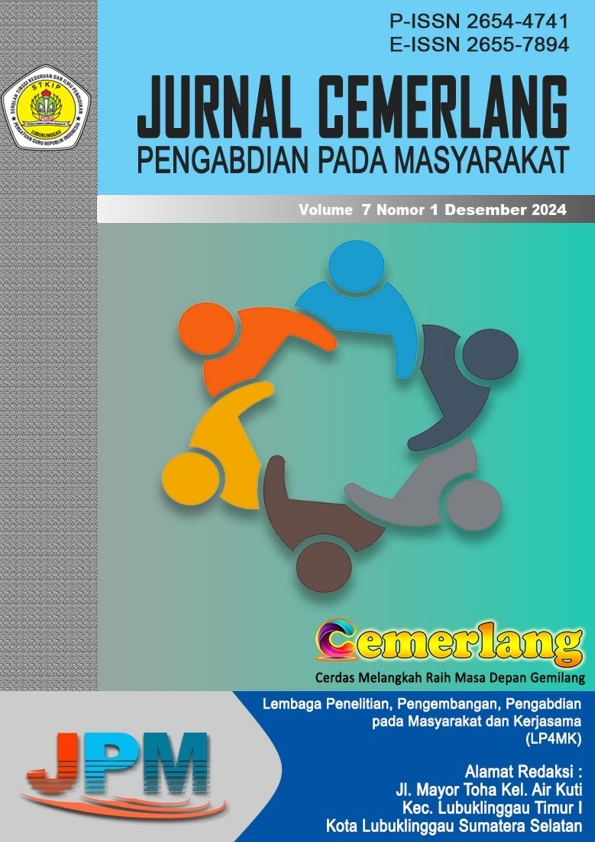Building Community Awareness for Environmental Care Through Ecobrick and Ecoprint Production
Abstract
This community service program aims to raise awareness among the residents of Padukuhan Juawangen, Kalasan, Yogyakarta about the importance of environmental preservation through the creative processing and utilization of plastic waste and organic waste. Participants are given an understanding of the concepts of ecobrick and ecoprint as innovative solutions for waste management and environmental conservation. The making of ecobricks teaches participants how to process plastic waste into functional products, while the ecoprint technique introduces a method of environmentally friendly fabric dyeing using natural materials. The program is carried out in three stages: preliminary, implementation, and closing. In the preliminary stage, community awareness and habits in waste management are identified, and the necessary infrastructure is prepared. The implementation stage includes educating participants on the importance of environmental preservation, presenting material on ecobrick and ecoprint, and conducting direct demonstrations and practices. The closing stage involves evaluating and obtaining feedback from participants. The results of this program show active community participation with high enthusiasm and positive responses toward the adoption of environmentally friendly practices. Interviews revealed that the program provided new insights into waste management and encouraged participants to be more active in sorting and processing waste into creative products. Survey results show that 93.3% of participants strongly agree that the program was conducted with sufficient time and facilities, and that the instructors were clear in delivering the material. Additionally, 84% of participants stated that the program was effective in raising environmental awareness, while 83.3% strongly agreed that the program improved their skills in processing plastic waste. Furthermore, 95.3% of participants strongly agreed that the program was beneficial in increasing their knowledge of ecoprint and ecobrick techniques and processes. The program also motivated 80.6% of participants to continue creating ecobricks and ecoprints.
References
Faiz, P. M. (2016). Perlindungan terhadap Lingkungan dalam Perspektif Konstitusi. Jurnal Konstitusi, 13(4), 766. https://doi.org/10.31078/jk1344
Faridatun, F. (2022). Ecoprint ; Cetak Motif Alam Ramah Lingkungan. Jurnal Prakarsa Paedagogia, 5(1). https://doi.org/10.24176/jpp.v5i1.9002
Iyabu, N., Duludu, U. A. T. ., & Zubaidi, M. (2021). Peran Masyarakat Dalam Pengolahan Sampah Di Kelurahan Pentadu. Jambura Journal of Community Empowerment, 2(1), 13–22. https://doi.org/10.37411/jjce.v2i1.691
Kahfi, A. (2017). Overview of Waste Management. Jurisprudentie: Department of Law, Faculty of Sharia and Law, 4(1), 12.
Lesna Nainggolan, E., Teovani Lodan, K., & Salsabila, L. (2023). Menuju Keberlanjutan Lingkungan: Keterlibatan Masyarakat dalam Pengelolaan Sampah Kota Batam. PUBLIKA : Jurnal Ilmu Administrasi Publik, 9(2), 179–188. https://doi.org/10.25299/jiap.2023.13584
Pertiwi, D., & Sari, R. M. (2023). Peran Pekerja Sosial dalam Mendukung Kebijakan Pengelolaan Sampah di Yogyakarta Pendahuluan. 2(4), 246–258.
Purwani, S. (2023). Ecoprint pada Kulit Domba Dengan Warna Pewarna Alami Tegeran, Tingi, dan Secang. Jurnal Socia Akademika, 9(1), 70–76.
Sunandar, A. P. (2020). Available online at: http://journal.uny.ac.id/index.php/jpmmp. J. Pengabdian Masyarakat MIPA Dan Pendidikan MIPA, 4(1), 113–121.
Waas, R. V. (2014). Perlindungan Hukum Terhadap Hak Atas Lingkungan ditinjau dari Perspektif Hukum International. Jurnal Sasi, 20(1), 81–91.
Yusiyaka, R. A., & Yanti, A. D. (2021). Ecobrick: Solusi Cerdas Dan Praktis Untuk Pengelolaan Sampah Plastik. Learning Community : Jurnal Pendidikan Luar Sekolah, 5(2), 68. https://doi.org/10.19184/jlc.v5i2.30819

Jurnal Pengabdian Masyarakat by http://ojs.stkippgri-lubuklinggau.ac.id/index.php/JPM is licensed under a Creative Commons Attribution-ShareAlike 4.0 International License.













